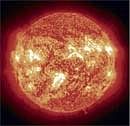

The sun is still blank (mostly). Ever since Samuel Heinrich Schwabe, a German astronomer, first noted in 1843 that sunspots burgeon and wane over a roughly 11-year cycle, scientists have carefully watched the sun’s activity. In the latest lull, the sun should have reached its calmest state last fall.
Indeed, last year marked the blankest year of the sun in the last half-century, 266 days with not a single sunspot visible from Earth. Then, in the first four months of 2009, the sun became even more blank. “It’s been as dead as a doornail,” David Hathaway, a solar physicist at NASA’s Marshall Space Flight Center in Huntsville, Ala., said a couple of months ago.
Maximum activity in May 2013
The sun perked up in June and July, with a sizeable clump of 20 sunspots. Now it is blank again, consistent with expectations that this cycle will be smaller and calmer, and the maximum activity, likely to arrive in May 2013, will not be all that maximum.
For operators of satellites and power grids, that is good news. The same magnetic fields that generate sunspot blotches also accelerate a devastating rain of particles that can overload and wreck electronic equipment in orbit or on Earth.
A panel of 12 scientists assembled by the National Oceanic and Atmospheric Administration now predicts that the May 2013 peak will average 90 sunspots. That
would make it the weakest solar maximum since 1928, which peaked at 78 sunspots.
During an average solar maximum, the sun has an average of 120 sunspots.
Among some global warming skeptics, there is speculation that the sun may be on the verge of falling into an extended slumber similar to the so-called Maunder Minimum, several sunspot-scarce decades during the 17th and 18th centuries that coincided with an extended chilly period. Most solar physicists do not think anything that odd is going on with the sun. With the recent burst of sunspots, “I don’t see we’re going into that,” Hathaway said last week.
Still, something like the Dalton Minimum, two solar cycles in the 1800s that peaked at an average of 50 sunspots, lies in the realm of the possible, Hathaway said. With better telescopes and a fleet of sun-watching spacecraft, solar scientists know a lot more about the sun than ever before. But they do not understand everything.
Much like the stock market...
Predicting the cycle is, in many ways, much like predicting the stock market. A full understanding of the forces driving solar dynamics is far out of reach, so scientists look to key indicators that correlate with future events and create models based on those.
For example, in 2006, Hathaway looked at the magnetic fields in the polar regions of the sun, and they were strong. During past cycles, strong polar fields at minimum grew into strong fields all over the sun at maximum and a bounty of sunspots. Because the previous cycle had been longer than average, Hathaway thought the next one would be shorter and thus solar minimum was imminent. He predicted the new solar cycle would be a ferocious one.
Instead, the new cycle did not arrive as quickly as Hathaway anticipated, and the polar field weakened. Last November, it looked like the new cycle was finally getting started, with the new cycle sunspots in the middle latitudes outnumbering the old sunspots of the dying cycle that are closer to the equator. After a minimum, solar activity usually takes off quickly, but instead the sun returned to slumber. The idea that solar cycles are related to climate is hard to fit with the actual change in energy output from the sun. From solar maximum to solar minimum, the sun’s energy output drops a minuscule 0.1 per cent. But the overlap of the Maunder Minimum with the Little Ice Age, when Europe experienced unusually cold weather, suggests that the solar cycle could have more subtle influences on climate.
Of cosmic rays
One possibility proposed a decade ago by Henrik Svensmark and other scientists at the Danish National Space Center in Copenhagen looks to high-energy interstellar particles known as cosmic rays. When cosmic rays slam into the atmosphere, they break apart air molecules into ions and electrons, which causes water and sulfuric acid in the air to stick together in tiny droplets. These can grow into clouds, and clouds reflect sunlight, potentially lowering temperatures.
The sun, Danish scientists say, influences how many cosmic rays impinge on the atmosphere and thus the number of clouds. When the sun is frenetic, the solar wind of charged particles it spews out increases. That expands the cocoon of magnetic fields around the solar system, deflecting some of the cosmic rays.
But, according to the hypothesis, when the sunspots and solar winds die down, the magnetic cocoon contracts, more cosmic rays reach Earth, more clouds form, less sunlight reaches the ground, and temperatures cool.
“I think it’s an important effect,” Svensmark said, although he agrees that carbon dioxide is a greenhouse gas that has certainly contributed to recent warming.
Svensmark and his colleagues found a correlation between the rate of incoming cosmic rays and the coverage of low-level clouds between 1984 and 2002. They have also found that cosmic ray levels, reflected in concentrations of various isotopes, correlate well with climate extending back thousands of years.